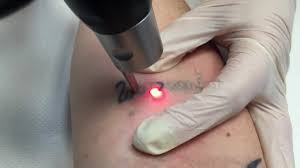Introduction to Laser Tattoo Removal
Understanding Laser Tattoo Removal
Laser tattoo removal (ازالة الوشم بسعر في الرياض)is a revolutionary procedure that uses advanced laser technology to break down tattoo ink particles in the skin. These particles are then naturally eliminated by the body’s immune system, gradually fading the tattoo. This method is highly effective, safe, and minimally invasive, making it a popular choice for those seeking to remove unwanted tattoos.
Why People Choose Tattoo Removal
People opt for tattoo removal for various reasons, including personal changes, professional requirements, or dissatisfaction with the tattoo's quality or design. Laser tattoo removal offers a second chance for your skin, allowing you to erase past mistakes and start anew.
How Laser Tattoo Removal Works
The Science Behind the Process
Laser tattoo removal works by targeting the ink particles with high-intensity light beams. These beams break the ink into smaller fragments, which are then absorbed and expelled by the body's immune system. The specific wavelength of the laser is chosen based on the color of the ink, ensuring precise and effective treatment.
Types of Lasers Used
Different types of lasers are used in tattoo removal, including Q-switched Nd
, Alexandrite, and Ruby lasers. Each laser is suited for specific ink colors and skin types, allowing for customized treatment plans that maximize effectiveness and minimize risks.The Laser Tattoo Removal Procedure
Initial Consultation and Assessment
The first step in the laser tattoo removal process is an initial consultation. During this session, the practitioner will assess the tattoo’s size, color, depth, and the patient’s skin type. This information is crucial for developing a personalized treatment plan and setting realistic expectations for the results.
The Treatment Sessions
Each laser tattoo removal session typically lasts between 10 to 30 minutes, depending on the size and complexity of the tattoo. Most tattoos require multiple sessions, spaced several weeks apart, to achieve optimal results. This interval allows the body time to break down and eliminate the ink particles.
Pain Management and Comfort
The sensation during laser tattoo removal is often described as similar to the snap of a rubber band against the skin. To minimize discomfort, topical anesthetics can be applied before the procedure. Post-treatment, the area might feel like a mild sunburn, but this discomfort usually subsides quickly.
Factors Affecting Laser Tattoo Removal
Tattoo Characteristics
The effectiveness of laser tattoo removal depends on several factors, including the tattoo’s age, color, and depth. Older tattoos and those with black ink are generally easier to remove, while multi-colored tattoos may require different lasers for different colors.
Skin Type and Health
The patient’s skin type and overall health also play a significant role in the removal process. Individuals with lighter skin tones often see faster results, and a healthy immune system helps expedite the elimination of ink particles.
Benefits of Laser Tattoo Removal
High Success Rates
One of the primary benefits of laser tattoo removal is its high success rate. Modern laser technology can effectively treat even the most stubborn inks, providing a reliable solution for those looking to remove their tattoos completely.
Minimal Risk of Scarring
Compared to other tattoo removal methods, laser treatment significantly reduces the risk of scarring. The lasers target only the ink particles, leaving the surrounding skin largely unaffected and promoting better healing and aesthetic outcomes.
Precision and Versatility
Laser tattoo removal offers unmatched precision, allowing practitioners to target specific areas without damaging adjacent skin. This precision makes it suitable for tattoos in sensitive areas and for partial removals or modifications.
Understanding Potential Risks and Side Effects
Common Side Effects
Common side effects of laser tattoo removal include redness, swelling, and blistering in the treated area. These effects are usually temporary and subside within a few days to a week after each session.
Rare Complications
In rare cases, patients may experience hyperpigmentation (darkening of the skin) or hypopigmentation (lightening of the skin). Additionally, there's a slight risk of infection if proper aftercare instructions are not followed.
Aftercare and Recovery
Immediate Post-Treatment Care
After each session, it’s crucial to keep the treated area clean and dry. Applying an antibiotic ointment and a sterile bandage can help prevent infection. Avoiding sun exposure is essential, as the skin is particularly sensitive during the healing process.
Long-Term Care Tips
For long-term care, using a broad-spectrum sunscreen on the treated area helps protect it from UV damage. Moisturizing the skin regularly and following any specific instructions provided by the practitioner can further enhance the healing process.
Monitoring the Healing Process
Regular follow-up appointments are essential to monitor the progress and adjust the treatment plan if necessary. Any unusual side effects or concerns should be promptly reported to ensure a smooth recovery.
Choosing the Right Provider
Importance of Experience and Expertise
Selecting a provider with extensive experience in laser tattoo removal is crucial for achieving the best results. An experienced practitioner will have a deep understanding of different skin types and ink colors, ensuring safe and effective treatment.
Key Questions to Ask
When choosing a provider, consider asking about their experience, the types of lasers they use, and the expected number of sessions. Inquiring about costs, payment plans, and any potential side effects can also help in making an informed decision.
Reading Reviews and Testimonials
Online reviews and testimonials from previous patients can provide valuable insights into a provider’s reputation and success rate. Positive feedback and high satisfaction rates are good indicators of a reliable and skilled practitioner.

